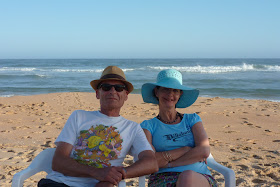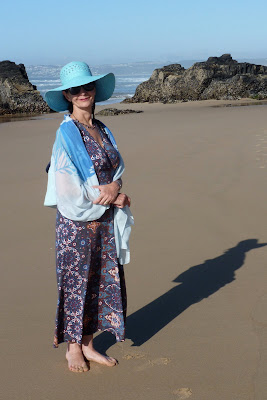Six hours from Cape Town, on the Garden Route toward
Nature’s Valley, lies the Keurbooms River Nature Reserve - unspoilt,
unpolluted beauty, far from the madding crowd
An ancient river, the placid waters of its estuary
hide its tortuous journey through the inland
mountain valleys as it plunges into a spectacular gorge
And pours into the golden sand-rimmed bay a few miles
from what is affectionately known as 'Plett' - originally christened
"Bahia Formosa" - beautiful bay - by early
Portuguese explorers
 |
| Where we are greeted by the attentive staff - including a very cool Rasta retainer called Peter, his wife, the delightful Florina and Gina the Cook |
Mint greens and pastel pinks create a calm and relaxed holiday atmosphere
Breakfast on the terrace is the start of a weekend of hedonistic delight
Our charming and very energetic host and our hostess-in-absentia
 |
| Soft New England-style décor creates a perfect ambiance for our sybaritic sojourn |
Glazed terraces add a contemporary note and provide beautiful vantage points
from which to survey the dazzling mountain and sea views
from which to survey the dazzling mountain and sea views
Casual attire is the order of the day - here Mr P wears his vintage 'I love Africa t-shirt'
 |
| And here Mr P at the pool - deciding whether to get in or not |
 |
| Our bedroom with lovely old kelim and Mr P's trusty trilby |
 |
| Simple fabrics and a comfy bed - what more could one ask for? |
 |
A Tessa Kiros cookbook should one get bored The odd novel to pass the time - and this one is odd |
And the most amazing sea view right from the bedroom window
The very helpful Peter set up our umbrellas and chairs on the sand
Then all one had to do was gaze out to sea and dream
 |
| Read an occasional line or two in between the arduous task of applying Factor 15 |
 |
| Then there was the difficult job of climbing up to the lunch terrace |
Where with our London friends Sue and Keith, after a hard day at the beach, we were served the most generous of banquets
Beautiful salads, lavish roast chicken, enormous platters of smoked fish -
enough for a family of at least dozen - until we realised it did feed a family - the staff no doubt enjoying the copious 'left-overs'
enough for a family of at least dozen - until we realised it did feed a family - the staff no doubt enjoying the copious 'left-overs'
An afternoon nap on the terrace was the order of the day once lunch was over
Followed by a late afternoon beach stroll
Lots of opportunities for photo shoots
Reverse angle on very chilled Mr P
The Chance Muse could get used to
this but has decided we need a more serious approach to matters
ecological and natural - and so offers the nature lover a guide to the
local fauna and flora
A variety of habitats are conserved and patches of virgin Knysna forest still grow
in protected kloofs tumbling into coastal fynbos above the sea. One is
immediately made aware of a strange smell - a salty bitterness that
takes me straight back to childhood holidays at Plett...
The dining room with huge plate glass window proved a wonderful place from which to observe
the local wild life
On a fine day one can be lucky enough to spot caracal, the shy blue duiker, bushbuck,
grysbok, or even a lone leopard
Other common sightings are mongoose and the very friendly vervet
monkey
An exciting
opportunity to see the last remaining forest elephants of South Africa
Some of whom mate for life and are always seen in pairs
 |
| Where the female is always the boss although the males of the species are good at bar-b-queing, changing light bulbs and occasional rewiring of plugs |
 |
| The entire area teems with birdlife - nearly 300 species are to be found in the great variety of habitats ranging from fynbos to forest to wetlands |
Most notably are the Malachite and Giant Kingfisher pictured above
And the distinctive and comical Knysna Lourie with its flashes of red and deep green plumage - which announces its presence by a sort of deep grunting as it hops around from tree to tree
But the verdant hills also conceal the regal fish eagle - above courtesy of forestedge.co.za - as well as the reed cormorant, yellow-billed duck and the black-headed oriole, to name a few
But the verdant hills also conceal the regal fish eagle - above courtesy of forestedge.co.za - as well as the reed cormorant, yellow-billed duck and the black-headed oriole, to name a few
The Knysna Woodpecker with its peculiar gait and distinctive colouring can be quite stand-offish on first meeting but warms on later acquaintance
 |
| Various visiting Sunbirds flourish in these sunny climes though they have on occasion been noted to develop more nocturnal habits |
The peripatetic Strandlooper is a very communicative creature prone to long hours chatting to its mates and sporting plumage that indicates a strong propensity to support Arsenal
And favours gathering at water holes along the way with like-minded folk, where thirst is quenched by a favourite pre-dinner tipple
Though some species prefer a good red of some vintage - believing in the old adage that all things come to those who wait as long as one remains young at heart
The mating habits of the little
grebe and the great crested hamerkop can be quite endearing
 |
| But what's that coming over the hill...? Could it be...? |
 |
| A rare sighting of the European swallow! |
 | |||||
| Migrating every season -- an escape from her usual chilly northern hemisphere habitat - to be glimpsed on occasion sporting specially adapted headgear to ward off the fierce rays of African sun |

Don't look now, dear, but their are two strange birds following us. Definitely not locals.
 |
|
If we don't turn around they may not notice us... Too late! |
And as the sun sets in the southern ocean we hope these nature notes have been edifying




















































No comments:
Post a Comment